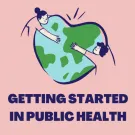Is COVID-19 still a “thing” in 2023? With fewer case numbers, updated booster vaccines, and life seemingly returning to normal, this question gets asked a lot. Despite these changes, the answer is yes: COVID-19 is still a “thing” in 2023 and should be taken seriously.
“But case numbers are down, is it even considered a pandemic anymore?”
Despite lower case numbers, hospitalizations, and deaths compared with the height of the pandemic, COVID-19 infections and deaths still happen and pose a real threat, especially to those who are not vaccinated, or have weak immune systems like seniors or immunocompromised individuals.
The effects of COVID-19 are more important than its classification as a pandemic. For example, the yearly flu is still taken seriously, although it isn’t a pandemic and doesn’t reach the numbers that COVID-19 did in 2020 or 2021. People get vaccinated against the flu and (hopefully) stay home (or “quarantine”) when they’re sick. People can be hospitalized and die from the flu. Even if a virus like the flu isn’t considered a pandemic, that doesn’t mean it isn’t real or something that shouldn’t be taken seriously.
“But I’m healthy and young. It’s not a threat to me, is it?”
COVID-19 poses a threat to everybody. Like any virus, severe effects, including death, are far more likely among people at high risk. People at high risk of severe health outcomes, hospitalization or death from COVID-19 are those who are not vaccinated, have chronic conditions, have weak immune seniors such as seniors, and immunocompromised individuals. However, that doesn’t mean people at lower risk have nothing to worry about.
Doctors and scientists are also starting to truly understand the experience of post-COVID (also called long COVID), where people experience symptoms for weeks or even years after being infected with COVID-19, even if the initial infection appeared to be mild. Symptoms of post-COVID vary but can include respiratory and heart symptoms, fatigue and neurological symptoms, digestive symptoms, and more. The effects of post-COVID vary for everyone and can be difficult to manage. If you get COVID-19, even if you’re healthy, there is a chance that your life will never be the same again.
You can contract COVID-19 multiple times. If you’ve been infected with the virus before, that doesn’t mean you’re immune to it. The more times you contract it, the higher your chances are of developing post-COVID.
This article from the Centers for Disease Control and Prevention explains post-COVID conditions, and this article from Washington University School of Medicine in St. Louis explains the factors that can lead to long COVID.
“So, what about people at high risk of poor health outcomes from COVID-19?”
COVID-19 is a real threat to everyone, especially people at high risk. Compared with people who are healthy or at low risk, people at high risk are more likely to experience severe complications from COVID-19.
Many conditions can put someone at high risk for COVID-19, especially conditions that affect the immune system or the body’s way of fighting sicknesses, called “immunocompromised.” The immune system in immunocompromised people, such as people with autoimmune diseases, or those taking immunosuppressive medications, can’t effectively fight off sicknesses caused by bacteria or viruses.
Other groups that are at high risk include the elderly, people who are pregnant, people with cancer, people with asthma, and young children (especially premature babies), among others. Being at high risk for COVID-19 isn’t rare, and people at high risk are in every population group.
This article from the Centers for Disease Control and Prevention explains different risk groups for COVID-19.

“What can I do?”
Continuing COVID-19 precautions in 2023 is simple: get vaccinated against COVID-19 and stay up to date on booster shots. The initial vaccine is the most important one to get. This article from the World Health Organization explains the different COVID-19 vaccines and how they work. And this article from the Centers for Disease Control and Prevention explains the U.S. recommendations for COVID-19 vaccines and boosters.
Wearing a high-quality face mask (like an N95 respirator) most of the time is ideal, but that may be unrealistic today in the United States. Instead, you can reduce the risk for yourself and everyone around you by wearing a face mask during times with a high risk of COVID-19 transmission. For example, you might not wear a face mask in a grocery store, but you might choose to wear one at an indoor concert, where the risk of spreading COVID-19 is very high because many people are close together for a long time. The more you wear a face mask, the more you prevent the spread of COVID-19.
This article from the World Health Organization explains when to wear a face mask. And this article from the Centers for Disease Control and Prevention shares the different types of face masks and how to wear them.
Wearing a face mask when sick or when air quality is poor was normal in many countries (e.g., Japan, China, South Korea) before COVID-19. Just because it isn’t normal in the United States doesn’t mean it isn’t the norm around the world. The fact that many countries normalized mask-wearing before COVID-19 shows how effective masks are at keeping individuals and their communities safe.

To help prevent the spread of COVID-19, get tested after attending a large event or before visiting someone at high risk for COVID-19. These articles from the Centers for Disease Control and Prevention explain the different types of COVID-19 tests and when to get tested and can help you find a local testing site.
If you think you have COVID-19, a few of the easiest but most effective things you can do are wear a high-quality face mask and avoid high-transmission events. If you’re sick, stay home as much as possible (as with any virus, not just COVID-19). If you can’t stay home, wearing a high-quality face mask and avoiding crowds (especially indoor crowds in rooms with minimal ventilation) are very effective ways to help prevent the spread of COVID-19.
Make active decisions about COVID-19 and remember to do the simple things that have a large impact.

“Why would a person at high risk attend a high-transmission event? Why should I go out of my way to protect them?”
People at high risk should be able to enjoy their lives like anyone else. They deserve to go to concerts, conventions, and other large gatherings. However, most people at high risk may be less likely to attend these events because of their risk of getting severely ill from COVID-19 or other viruses. Although many people at high risk aren’t likely to be at every large event you attend, they are at your school, work, places where you volunteer and shop, and so on.
If you’re carrying a virus that you contracted at a large event, then you can spread it to people at high risk wherever you go in your daily life. “Super-spreader” events are called that because a large number of people who attend are likely to (a) get sick and (b) spread the virus throughout their community.
Having the virus and being “asymptomatic”—where no symptoms are showing—is very common, especially in people vaccinated against COVID-19. These people could be infected with COVID-19 but not know it until they’re tested, and they will unknowingly spread it to people around them. Wearing a high-quality face mask at a high-transmission event is one way to limit the spread of infection that will protect yourself, others at the event, and people in your day-to-day life. Getting tested after attending such events is another way to help prevent you from unknowingly spreading the virus.
This article from the Centers for Disease Control and Prevention can help you find a local testing site.

“I want to wear a face mask, but I’m worried about getting bullied.”
You have a right to wear a face mask, even when it’s not required. No one can force you to take it off—not your teacher, your boss, your friends, or anyone else. Remember that wearing a face mask some of the time is better than never wearing one. Wearing a face mask only at large, high-transmission events or when you are (or think you might be) sick makes a big difference.
Being a changemaker means caring for your local community, including doing what you can to prevent harm to others. Taking precautions and a conscious approach to prevent the spread of COVID-19, particularly among community members in your life who may be at high risk, in 2023 is an easy way to make real change.
Here are more resources about COVID-19:
- This page from the Centers for Disease Control and Prevention explains what COVID-19 is, what to do if you’re sick, and more.
- This page from the World Health Organization’s COVID-19 Dashboard includes an interactive map and other resources for staying up-to-date on COVID-19.
- This page from the Centers for Disease Control and Prevention contains updates on the most recent science regarding COVID-19.




